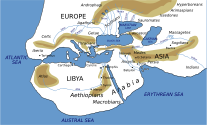Achaemenid conquest of the Indus Valley
| Achaemenid conquest of the Indus Valley | |||||||
|---|---|---|---|---|---|---|---|
| Part of the Conquests of Achaemenid Empire | |||||||
 Eastern border of the Achaemenid Empire and the kingdoms and cities of ancient India (circa 500 BCE).[1][2][3][4] | |||||||
| |||||||
| Belligerents | |||||||
| Achaemenid Empire | Mahajanapadas | ||||||

The Achaemenid conquest of the Indus Valley refers to the Achaemenid military conquest and governance of the territories of the North-western regions of the Indian subcontinent, from the 6th to 4th centuries BC. The conquest occurred in two phases. The first invasion was conducted around 535 BCE by Cyrus the Great, who founded the Achaemenid Empire.[1] Cyrus annexed the regions west of the Indus River, which formed the eastern border of his empire. Following the death of Cyrus, Darius the Great established his dynasty and began to reconquer former provinces and further expand the extent of the empire. Around 518 BCE Darius crossed the Himalayas into India to initiate a second period of conquest by annexing regions up to the Jhelum River in Punjab.[6]
The first secure epigraphic evidence, given by the Behistun Inscription, gives a date before or about 518 BCE. Achaemenid penetration into the area of the Indian subcontinent occurred in stages, starting from northern parts of the River Indus and moving southward.[7] The Indus Valley was formally incorporated into the Achaemenid Empire as the Gandāra, Hindush, and Sattagydia satrapies, as mentioned in several Achaemenid inscriptions.
The Achaemenid occupation of the Indus Valley decreased over successive rulers and formally ended around the time of the Alexander's conquest of Persia. This gave rise to independent kings such as Porus (ruler of region between Jhelum and Chenab rivers), Ambhi (ruler of region between Indus and Jhelum rivers with capital at Taxila) as well as gaṇa sanghas or republics, which confronted Alexander during his Indian campaign circa 323 BCE.[1] The Achaemenid Empire set a precedence of governance through the use of satrapies,[8] which was further implemented by Alexander's Empire, the Indo-Scythians, and the Kushan Empire.
Background and invasion[]


For millennia, the northwestern part of India had maintained some level of trade relations with the Near East. Finally, the Achaemenid Empire underwent a considerable expansion, both east and west, during the reign of Cyrus the Great (c.600–530 BC), leading the dynasty to take a direct interest into the region of northwestern India.[1]
- Cyrus the Great
The conquest is often thought to have started circa 535 BCE, during the time of Cyrus the Great (600-530 BCE).[9][10][1] Cyrus probably went as far as the banks of the Indus river and organized the conquered territories under the Satrapy of Gandara (Old Persian cuneiform: WIKI
